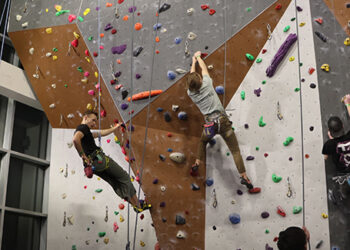
While you can’t gain in-person feedback from your virtual Group X classes, there are a number of creative ways to improve participant response rates and obtain general information to help improve future classes.
Facebook Live and Zoom Polls
One of the easiest ways to start improving feedback response is to incorporate polls when streaming on Facebook Live and Zoom. Olivia Greer, an adjunct instructor for Recreational Sports and Fitness at American University, said when using Zoom, polls are implemented at the beginning of class and the instructor guides individuals to participate.
On Facebook Live, polls are set up to stay on the entire class and continue after the live video has ended. “I have found most users on Facebook are viewing our videos after the fact instead of live, so it is vital to have this setting on for those who view on their own time,” she said.
Getting participants to provide feedback is one task, but deciding what to ask and how often truly determines how you will be able to implement the data you receive. Greer said she is currently keeping polls to one question and is focusing on gauging what times throughout the day patrons are more likely to participate in a live class, as well as the types of classes they are looking for.
“The idea is to use this information in planning and prepping for our summer session,” said Greer. “I also spread out the types of questions in the upcoming weeks to alternate between classes so it’s not the exact same question each class.”
Below, Greer shared the topics she has found helpful to ask questions around:
- Best time for exercising
- Favorite way to exercise
- Type of music or themes for classes
Additionally, Greer plans to start asking which types of equipment patrons have at home to gain insight on what is a “common” household item for potentially hosting at-home strength classes. “I have also used polls on Facebook Live to determine what type of mediation patrons are interested in for our Mid-Day Break,” she said. “This has been helpful in planning classes throughout the week.”
Net Promoter Score (NPS)
NPS is used to measure member experience through surveying, and most schools already have surveying platforms with NPS built in, such as Qualtrics. Steven Trotter, the associate director of Wellness and Fitness at East Carolina University, said there’s no need to reinvent the wheel when all you have to do is add in a question.
“If you are doing on-demand where participants go to your website and select which workouts they want to do, you could use a pop-up survey for NPS that occasionally will come up on the screen while someone is on the page,” he said. “It sends a question, and participants respond on a scale of one to 10.”
Below, Trotter breaks down the NPS categories:
- Nine and 10 are promoters who will actively provide word of mouth marketing.
- Seven and eight are passive individuals who are happy, will continue to participate, but won’t vocally express their experience.
- Zero to six are detractors who had a memorable experience, but not in a positive way.
In virtual Group X classes, Trotter said his departments asks questions such as, “How likely are you to recommend this class,” and “How likely are you to recommend this instructor, coach or trainer?” Also provided is an open box for the participant to explain why they chose that answer. “We start getting baselines and make decisions off that data for programs and classes we’re offering,” he explained.
Overall, Greer and Trotter both place importance on first thinking about the feedback you’re trying to get and how you will use it. “Are you just trying to get immediate feedback on the experience, or are you trying to catch broader feedback of what people are wanting when it comes to virtual programming?” asked Trotter. “Define what the purpose of getting feedback is to begin with and narrow down, because if you ask more than a couple questions, people aren’t going to do it.”











Would be interested to learn the effectiveness of asking the “how likely” question as it does not necessarily mean that action will take place. It does give us a sense of satisfaction, but what is it we really want to know? I go to Starbucks regularly and am asked frequently on surveys about “how likely” and I answer high but I have never told someone that I recommend they go to Starbucks.